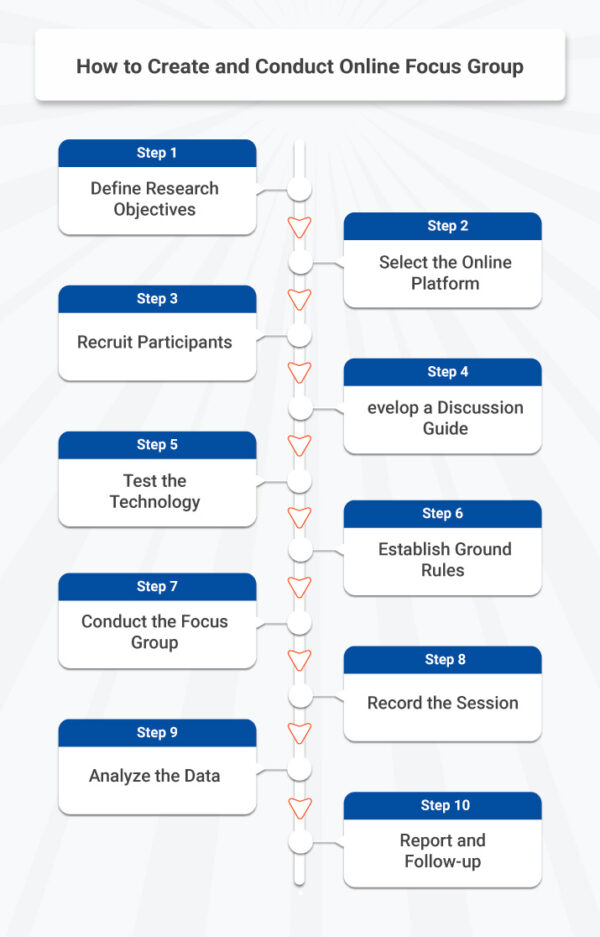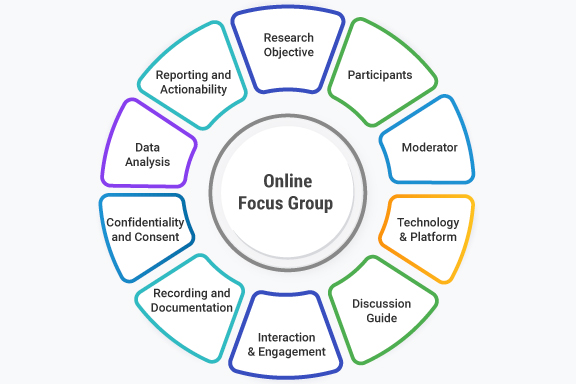What is an Online Focus Group?
An online focus group is a method of gathering qualitative data through structured group discussions conducted via the internet. It offers a digital alternative to traditional in-person focus groups, enabling businesses to collect valuable insights from participants in different locations. Online focus groups are a powerful tool for understanding customer perceptions, testing new products, and refining marketing strategies—all in a virtual environment.
With advances in technology, conducting online focus groups has become more accessible, allowing businesses to engage participants globally and gather insights without geographic constraints. It typically involves a moderator, guiding participants through a discussion via video calls, chat platforms, or specialized online focus group software.
Key Elements of an Online Focus Group
By incorporating the following key elements and executing an online focus group, researchers can optimize the process, gather valuable insights, and achieve their research objectives effectively.
- Research Objective: Clearly define the research objective or the specific goals you aim to achieve through the online focus group. This will guide the entire process and ensure that discussions and questions align with the intended purpose.
- Participants: Select participants who represent your target audience or possess relevant experiences and perspectives. Use screening questionnaires to ensure participants meet the desired characteristics and demographics. Aim for a diverse group to gather a wide range of insights.
- Moderator: Appoint a skilled moderator who can facilitate the online focus group effectively. The moderator should possess strong facilitation skills, be able to manage group dynamics, encourage open discussions, and ensure equal participation among participants.
- Technology and Platform: Choose a reliable online platform or focus group software that supports seamless communication and interaction. Ensure that participants are comfortable with the chosen technology and conduct a technology check before the session to address any potential issues.
- Discussion Guide: Prepare a well-structured discussion guide that includes a series of questions and topics to guide the conversation. The guide should cover all relevant aspects related to the research objective and provide flexibility for participants to share their thoughts and insights.
- Interaction and Engagement: Encourage active participation and engagement among participants. Use interactive techniques such as probing questions, visual stimuli, or brainstorming exercises to stimulate discussions and elicit in-depth responses.
- Confidentiality and Consent: Prioritize participant confidentiality and obtain informed consent before the focus group. Assure participants that their responses will be anonymized and used solely for research purposes. Follow ethical guidelines and data protection regulations.
- Recording and Documentation: Record the online focus group session with participant consent to ensure accurate capture of discussions. Additionally, take detailed notes to document key insights, participant quotes, and notable observations. This documentation will be invaluable for analysis and reporting.
- Data Analysis: After the online focus group, analyze the collected data using qualitative research techniques. Identify patterns, themes, and emerging insights from the discussions. Consider using qualitative research software to assist in organizing and analyzing the data effectively.
- Reporting and Actionability: Summarize the key findings and insights from the online focus group in a comprehensive report. Ensure that the findings are actionable and can be used to inform decision-making processes within the organization or research project.
Why Use Online Focus Groups?
Online focus groups offer several advantages over traditional, in-person focus groups:
- Wider Reach: Companies can engage participants from diverse locations and demographics, ensuring a more representative sample of the target market.
- Cost Efficiency: Hosting focus groups online reduces costs associated with travel, venue rental, and other logistical expenses, making it more affordable to conduct research.
- Convenience and Flexibility: Participants can join from anywhere, making it easier to schedule sessions and accommodate different time zones. This flexibility leads to higher participation rates.
- Anonymity: Online formats can provide participants with a sense of anonymity, encouraging more honest and open feedback.
Learn more: What is Focus Group Research?
2 Key Types of Online Focus Groups
When it comes to conducting online focus groups, understanding the different types available can help researchers choose the most suitable approach for their specific research objectives. In this section, we will explore the two primary types of online focus groups: synchronous and asynchronous. Let’s delve into the types of online focus groups and gain insights into their unique characteristics and applications.
1. Synchronous Online Focus Groups
Synchronous online focus groups involve real-time interactions among the participants and a moderator. This type typically utilizes video conferencing tools like Zoom, Skype, or other similar platforms. Participants can see and hear each other, facilitating a dynamic discussion environment. Synchronous online focus groups offer advantages such as immediate feedback, visual cues, and the ability to build on each other’s responses. They can closely simulate the experience of traditional face-to-face focus groups.
2. Asynchronous Online Focus Groups
Asynchronous online focus groups involve participants providing responses and feedback at their own convenience within a specified timeframe. Communication occurs through online discussion boards, email, or specialized focus group software. Participants do not need to be available simultaneously, allowing for flexibility across different time zones and schedules. Asynchronous online focus groups provide participants with more time to reflect on questions and offer thoughtful responses. They are particularly useful when participants may have scheduling conflicts or when a longer duration of data collection is desired.
How to Create and Conduct Online Focus Group

Creating and conducting an online focus group involves several steps to ensure its success. By following the steps described below, you can create and conduct an online focus group that generates valuable insights and contributes to your research objectives.
Step 1. Define Research Objectives: Clearly define the purpose and goals of the focus group. Determine what specific insights or information you seek to gather from the participants.
Step 2. Select the Online Platform: Choose a reliable and user-friendly online platform like Ideascale, that supports interactive discussions. Ensure that the chosen platform accommodates the number of participants and features necessary for your research.
Step 3. Recruit Participants: Identify and recruit participants who align with your target audience or possess relevant experiences. Develop a participant screening process using questionnaires or interviews to ensure the participants’ suitability.
Step 4. Develop a Discussion Guide: Create a structured discussion guide that includes a series of questions and prompts to guide the conversation. The guide should cover all relevant topics related to your research objectives. Ensure that the questions encourage open-ended responses and promote discussion among participants.
Step 5. Test the Technology: Familiarize yourself with the chosen online platform and conduct a technology check to ensure a smooth experience during the focus group. Test audio, video, screen sharing, and other relevant features. Inform participants about the platform requirements and provide them with any necessary instructions or technical support.
Step 6. Establish Ground Rules: Set clear guidelines and expectations for the online focus group, including rules for respectful communication and active participation. Inform participants about the session duration and any breaks planned. Encourage participants to listen actively, respect others’ opinions, and maintain confidentiality.
Step 7. Conduct the Focus Group: Start the session by introducing yourself, the moderator, and the purpose of the focus group. Create a welcoming and inclusive atmosphere. Follow the discussion guide, allowing participants to share their thoughts and engage in open dialogue. Encourage everyone to contribute and ensure that the conversation remains focused and on-topic.
Step 8. Record the Session: With participant consent, record the online focus group session for accurate documentation and analysis. Alternatively, consider taking detailed notes during the session to capture key insights, participant quotes, and observations.
Step 9. Analyze the Data: Transcribe the recorded session or review your notes. Use qualitative analysis techniques to identify patterns, themes, and insights from the discussion. Consider using qualitative research software to assist in organizing and analyzing the data effectively.
Step 10. Report and Follow-up: Summarize the findings and insights from the focus group in a comprehensive report. Present the results in a clear and concise manner, highlighting key themes and participant perspectives. Follow up with participants by sharing the outcomes and expressing gratitude for their participation.
Learn more: What is Focus Group?
Examples of Online Focus Groups
By harnessing the advantages of online platforms and virtual environments, researchers can conduct focus groups efficiently, eliminating geographical limitations and reducing logistical constraints. In this section, we will explore examples of how online focus groups can be applied across various industries and research objectives.
Example 1. Market Research Online Focus Group
An e-commerce company planning to launch a new product line can conduct online focus groups to gather insights on consumer preferences, and feedback on existing products, and identify potential areas for improvement. By engaging participants through online platforms, the company can obtain valuable customer feedback that can inform their marketing and product development strategies.
Example 2. Product Development
A software development company seeking to enhance customer experiences and refine product features can conduct online focus groups with existing users. Through virtual discussions, participants can provide feedback on usability, functionality, and overall satisfaction with the product. This input can help the company make informed decisions and prioritize improvements before releasing updates or new versions.
Example 3. Political Research
Political campaigns can utilize online focus groups to understand voter sentiments, evaluate campaign messages, and gauge public opinion on specific issues. By gathering a diverse group of participants virtually, campaign teams can engage in discussions, uncover insights, and tailor their strategies to resonate with the target audience effectively. Online focus groups offer a cost-effective way to gather qualitative research data and inform campaign decisions.
Example 4. Consumer Behavior Study
A market research agency conducting a study on consumer behavior and purchasing habits in a specific demographic can utilize online focus groups. Participants can share their experiences, preferences, and opinions related to various products and services. This data can help businesses understand consumer motivations, trends, and preferences, guiding their marketing and sales strategies.
Example 5. Employee Engagement and Satisfaction
Companies looking to gather feedback on employee satisfaction, work environment, and engagement levels can conduct online focus groups with their workforce. Virtual focus group sessions allow employees from different locations or remote work setups to participate and provide their perspectives. The insights gained can help organizations identify areas for improvement, refine policies, and enhance employee experiences.
Learn more: What is Market Research?
Top 10 Best Practices of Online Focus Groups

When it comes to conducting online focus groups, adhering to best practices is essential to ensure successful outcomes and gather meaningful insights. Online focus groups offer researchers the ability to engage with participants remotely, leveraging technology and virtual platforms for qualitative research. However, to maximize the effectiveness of these virtual sessions, it is crucial to follow established best practices. In this section, we will explore the key best practices for conducting online focus groups.
1. Clearly Define Research Objectives: Before conducting an online focus group, clearly define the research objectives and specific goals you aim to achieve. This clarity will help in designing effective questions and discussions that align with your research goals.
2. Select Participants Carefully: Carefully select participants who represent your target audience or have relevant experiences and perspectives. Use screening questionnaires to ensure participants possess the desired characteristics and demographics. Consider recruiting a diverse group to gather a wide range of insights.
3. Appoint a Skilled Moderator: A skilled moderator plays a crucial role in facilitating an online focus group. They should be experienced in guiding discussions, managing group dynamics, and ensuring equal participation. The moderator should encourage open and respectful dialogue among participants.
4. Test Technology and Platform: Prior to the focus group, test the chosen online platform or focus group software to ensure it functions smoothly. Familiarize yourself with the platform’s features, such as screen sharing, chat options, and recording capabilities. Conducting a technology check beforehand can help avoid technical issues during the session.
5. Set Ground Rules and Manage Time: Establish ground rules at the beginning of the session to ensure participants understand the purpose, guidelines, and expectations. Allocate sufficient time for each topic or question and manage the discussion flow effectively to stay on track. Avoid dominating participants and encourage everyone to contribute.
6. Foster a Safe and Confidential Environment: Create a safe and confidential environment for participants to freely express their opinions. Assure participants that their responses will be anonymized and used solely for research purposes. Respect participant confidentiality and obtain their informed consent.
7. Use Engaging Discussion Techniques: Employ interactive and engaging discussion techniques to encourage participants to share their thoughts. Use probing questions, and visual stimuli (if applicable), and encourage participants to build on each other’s responses. Foster a collaborative and comfortable atmosphere that facilitates in-depth conversations.
8. Record and Document: Record the online focus group sessions with participant consent to ensure accurate capture of discussions. Additionally, consider taking notes during the session to document key insights, participant quotes, and notable observations. This documentation will be valuable for analysis and future reference.
9. Analyze and Interpret Data: After the online focus group, analyze the collected data and identify key themes, patterns, and insights. Use qualitative analysis techniques to derive meaningful conclusions from the discussions. Consider using qualitative research software to assist in organizing and analyzing the data effectively.
10. Follow-up and Thank Participants: After the online focus group, provide participants with a summary of key findings from the session as a gesture of appreciation. Thank participants for their time, insights, and contributions to the research. Maintaining positive relationships with participants may encourage future participation in similar studies.
Learn more: What is Customer Experience (CX) Research?
Most Recent Blogs
Explore the latest innovation insights and trends with our recent blog posts.










